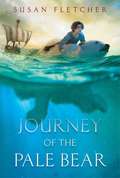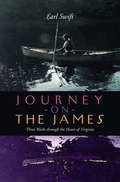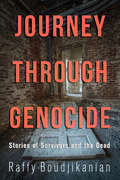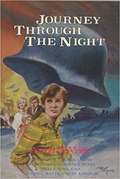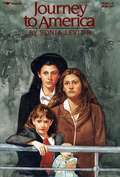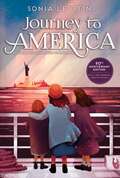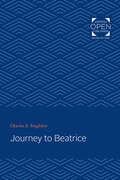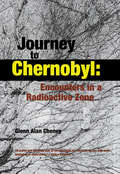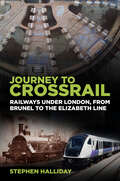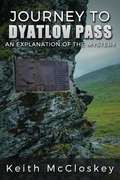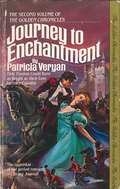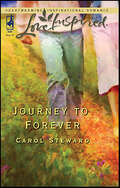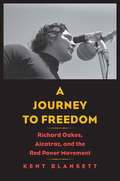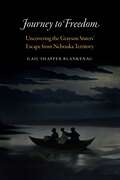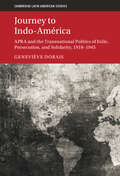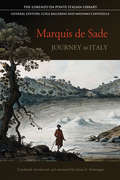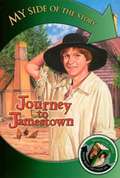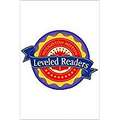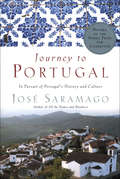- Table View
- List View
Journey of the Pale Bear
by Susan FletcherA runaway boy befriends a polar bear that’s being transported from Norway to London in this lyrical and timeless adventure story about freedom, captivity, and finding a family. <P><P>The polar bear is a royal bear, a gift from the King of Norway to the King of England. The first time Arthur encounters the bear, he is shoved in her cage as payback for stealing food. Restless and deadly, the bear terrifies him. Yet, strangely, she doesn’t harm him—though she has attacked anyone else who comes near. That makes Arthur valuable to the doctor in charge of getting the bear safely to London. So Arthur, who has run away from home, finds himself taking care of a polar bear on a ship to England. Tasked with feeding and cleaning up after the bear, Arthur’s fears slowly lessen as he begins to feel a connection to this bear, who like him, has been cut off from her family. But the journey holds many dangers, and Arthur knows his own freedom—perhaps even his life—depends on keeping the bear from harm. When pirates attack and the ship founders, Arthur must make a choice—does he do everything he can to save himself, or does he help the bear to find freedom? <P><P>Based on the real story of a polar bear that lived in the Tower of London, this timeless adventure story is also a touching account of the bond between a boy and a bear.
Journey on the James: Three Weeks through the Heart of Virginia
by Earl SwiftFrom its beginnings as a trickle of icy water in Virginia's northwest corner to its miles-wide mouth at Hampton Roads, the James River has witnessed more recorded history than any other feature of the American landscape -- as home to the continent's first successful English settlement, highway for Native Americans and early colonists, battleground in the Revolution and the Civil War, and birthplace of America's twentieth-century navy. In 1998, restless in his job as a reporter for the Norfolk Virginian-Pilot, Earl Swift landed an assignment traveling the entire length of the James. He hadn't been in a canoe since his days as a Boy Scout, and he knew that the river boasts whitewater, not to mention man-made obstacles, to challenge even experienced paddlers. But reinforced by Pilot photographer Ian Martin and a lot of freeze-dried food and beer, Swift set out to immerse himself -- he hoped not literally -- in the river and its history. What Swift survived to bring us is this engrossing chronicle of three weeks in a fourteen-foot plastic canoe and four hundred years in the life of Virginia. Fueled by humor and a dauntless curiosity about the land, buildings, and people on the banks, and anchored by his sidekick Martin -- whose photographs accompany the text -- Swift points his bow through the ghosts of a frontier past, past Confederate forts and POW camps, antebellum mills, ruined canals, vanished towns, and effluent-spewing industry. Along the banks, lonely meadowlands alternate with suburbs and power plants, marinas and the gleaming skyscrapers of Richmond's New South downtown. Enduring dunkings, wolf spiders, near-arrest, channel fever, and twenty-knot winds, Swift makes it to the Chesapeake Bay. Readers who accompany him through his Journey on the James will come away with the accumulated pleasure, if not the bruises and mud, of four hundred miles of adventure and history in the life of one of America's great watersheds.
Journey through Genocide: Stories of Survivors and the Dead
by Raffy BoudjikanianPowerful accounts by genocide survivors, a journalist seeking to bear witness to their pain. Darfuri refugee camps in Chad, Kigali in Rwanda, and the ruins of ancient villages in Turkey — all visited by genocide, all still reeling in its wake. In Journey through Genocide, Raffy Boudjikanian travels to communities that have survived genocide to understand the legacy of this most terrible of crimes against humanity. In this era of ethnic and religious wars, mass displacements, and forced migrations, Boudjikanian looks back at three humanitarian crises. In Chad, meet families displaced by massacres in the Darfur region of neighbouring Sudan, their ordeal still raw. In Rwanda, meet a people struggling with justice and reconciliation. And in Turkey, explore what it means to still be afraid a century after the author’s own ancestors were caught in the Armenian Genocide of 1915. Clear-eyed and compassionate, Boudjikanian breathes life into horrors that too often seem remote.
Journey through the Night
by Anne VriesThis book is a glimpse into the daily life and struggles of a Dutch family and their community during the German occupation of Holland.
Journey to America
by Sonia Levitin Charles RobinsonA Jewish family fleeing Nazi Germany in 1938 endures innumerable separations before they are once again united
Journey to America: Escaping the Holocaust to Freedom/50th Anniversary Edition with a New Afterword from the Author
by Sonia LevitinA beautifully repackaged 50th anniversary edition of Sonia Levitin&’s powerful classic story about a young Jewish girl forced to flee her home, winner of the National Jewish Book Award.In 1938, Lisa Platt and her family know something dangerous is happening in Germany. Lately, there have been more and more restrictions for Jews: yellow stars they have to wear, schools they cannot attend, things they are forbidden to do. When their neighbors are arrested for petty reasons, the Platts realize they have to escape. Forbidden to bring money or possessions out of the country, Lisa&’s father secretly leaves for America, planning to work until he can send for them. But when conditions in Germany worsen, Lisa, her mother, and her sisters flee to Switzerland to wait, surviving on what little they have in a continent hurtling toward war. Inspired by Sonia Levitin&’s own experience of fleeing Germany as a child, this moving novel chronicles one family&’s bravery in the face of aggression and apathy.
Journey to Avalon: The Final Discovery of King Arthur
by Chris Barber David PykittThis book reveals the true identity of Arthur, and locates his courts and long-forgotten battle sites such as Badon and Camlan. It also uncovers the secret of the mysterious Isle of Avalon and Arthur's resting place in a Breton church. The authors present a convincing and conclusive answer to the puzzle of King Arthur. Glossary of terms in Welsh and English. Bibliography. Index. 78 illustrations.
Journey to Beatrice
by Charles S. SingletonOriginally published in 1977. This volume recovers the allegory in Dante's Divine Comedy and presumes that readers' deficient knowledge of or interest in allegory have led to misinterpretations of Dante's poem. None of the dozens of commentaries on the Comedy published in the first half of the twentieth century was concerned with allegory more than sporadically, says Singleton, and so these treatments directed readers' attention to the merest disjecta membra of that continuous dimension of the poem. From Singleton's perspective, the allegory of the Comedy is an imitation of Biblical allegory, which was acknowledged by thinkers in the Middle Ages but not by intellectuals during and following the Renaissance. Singleton attempts to restore the allegorical elements to the foreground of interpreting the Comedy.
Journey to Chernobyl: Encounters in a Radioactive Zone
by Glenn Alan CheneyGlenn Cheney arrived in Kiev during those first days when the Soviet Union ceased to exist and Ukraine was reborn. Almost immediately he found himself talking with scientist, journalist, refugees, engineers, top-level government officials, doctors, environmentalists, parents of sick children and people living just a few kilometers from the Chernobyl complex. He heard stories about the disaster that went far beyond what had appeared in the Western press. The reports of atrocities, epidemics, tyrannyand dispair blend with a most unsual travelogue, considerable humor and KGB intrigue.
Journey to Crossrail: Railways Under London, From Brunel to the Elizabeth Line
by Stephen HallidayWhy did London have to wait so long for a main line railway beneath its streets? For a few years in the mid-nineteenth century, Isambard Kingdom Brunel’s broad gauge Great Western trains ran from Reading to Faringdon. Now, after many false starts, his vision is being realised as the Elizabeth Line carries passengers from Reading to the City once again and beyond Essex to Kent, using engineering that would have earned the admiration of the greatest Victorian engineers. London historian Stephen Halliday presents an engaging discussion of the fascinating origins and heroic engineering that made it all possible.
Journey to Dyatlov Pass: An Explanation of the Mystery
by Keith MccloskeyThis book describes the author's journey to the Dyatlov Pass in the northern Ural Mountains in the company of Russian Dyatlov "Obsessives". It is also a book for people who already know the Dyatlov story. The physical locations relating to the Dyatlov Incident are examined and discussed as well as competing theories from some of the group members about what happened. The second part of the book takes a critical look at the autopsies. This is followed by an intensive look at some ground-breaking research on the Dyatlov negatives by Valentin Gerasimovich Yakimenko. The final part of the book discusses the statements made by the two senior figures in the investigation and finishes with a scenario as to what may have happened on that fateful night of 1/2 February 1959.
Journey to Ellis Island: How My Father Came to America
by Carol BiermanAfter trekking across Europe and making it to Ellis Island on the Rotterdam in 1922, young Yehuda Weinstein, his mother, and his younger sister are almost turned away by immigration because he is wearing a sling, when fate intervenes.
Journey to Enchantment (The Golden Chronicles)
by Patricia VeryanBeautiful, flame-haired, fiercely independent Prudence has two passions: Scotland and the heroics of Ligun Doone, scourge of the hated Redcoats. And she is shocked when her father takes one of those Redcoats–a wounded English soldier–into their home on the shores of Loch Ness.But soon Prudence begins to suspect this Englishman is more than he seems–she fears he is a spy, even as she begins to surrender her heart. What's more, she is suddenly embroiled in a daring plot to rescue rebel Scots and smuggle a cypher containing the location of Bonnie Prince Charlie's lost treasure. This is her adventure of a lifetime, with even greater treasures to be found on her Journey to Enchantment.
Journey to Forever
by Carol StewardEight Days and 300 MilesThat was how long privileged fledgling journalist Nikki Post had to deal with notorious radio personality Colin Wright and the staff on his eight-day fund-raising trek from New Mexico to Wyoming.Yet instead of the immature prankster she'd been warned to expect, Colin was generous and handsome-with a smile that reached the depths of Nikki's soul. As the days counted down, he helped her write the article for her grandfather's newspaper-and a kiss shortened the distance between them.But when trouble threatened to bring the trip to a premature end, would Nikki's role in Colin's life end, as well...or continue forever?
Journey to Freedom: Richard Oakes, Alcatraz, and the Red Power Movement (The Henry Roe Cloud Series on American Indians and Modernity)
by Kent BlansettThe first book-length biography of Richard Oakes, a Red Power activist of the 1960s who was a leader in the Alcatraz takeover and the Red Power Indigenous rights movement A revealing portrait of Richard Oakes, the brilliant, charismatic Native American leader who was instrumental in the takeovers of Alcatraz, Fort Lawton, and Pit River and whose assassination in 1972 galvanized the Trail of Broken Treaties march on Washington, DC. The life of this pivotal Akwesasne Mohawk activist is explored in an important new biography based on extensive archival research and key interviews with activists and family members. Historian Kent Blansett offers a transformative and new perspective on the Red Power movement of the turbulent 1960s and the dynamic figure who helped to organize and champion it, telling the full story of Oakes’s life, his fight for Native American self-determination, and his tragic, untimely death. This invaluable history chronicles the mid-twentieth century rise of Intertribalism, Indian Cities, and a national political awakening that continues to shape Indigenous politics and activism to this day. TEST
Journey to Freedom: Uncovering the Grayson Sisters' Escape from Nebraska Territory
by Gail Shaffer BlankenauIn late November of 1858 two enslaved Black women—Celia Grayson, age twenty-two, and Eliza Grayson, age twenty—escaped the Stephen F. Nuckolls household in southeastern Nebraska. John Williamson, a man of African American and Cherokee descent from Iowa, guided them through the dark to the Missouri River, where they boarded a skiff and crossed the icy waters, heading for their first stop on the Underground Railroad at Civil Bend, Iowa. In Journey to Freedom Gail Shaffer Blankenau provides the first detailed history of Black enslavement in Nebraska Territory and the escape of these two enslaved Black women from Nebraska City. Poised on the &“frontier,&” the Graysons&’ escape demonstrated that unique opportunities beckoned at the confluence of Nebraska, Missouri, Iowa, and Kansas, and their actions challenged slavery&’s tentative expansion into the West and its eventual demise in an era of territorial fluidity. Their escape and the violence that followed prompted considerable debate across the country and led to the Nebraska legislature&’s move to prohibit slavery. Drawing on multiple collections, records, and slave narratives, Journey to Freedom sheds light on the Graysons&’ courage and agency as they became high-profile figures in the national debate between proslavery and antislavery factions in the antebellum period.
Journey to Independence: Blindness, The Canadian Story
by Euclid HerieThis book covers the history of the blind in Canada from the 19th century to the present. It's focus is on the leaders of the blind community that eventually led to the founding of the Canadian National Institute for the Blind, (CNIB). It's author, Euclid Heri, is a blind man and a leader in the world blind union as well as in Canada. He was the president of both the CNIB and the World Blind Union.
Journey to Indo-América: APRA and the Transnational Politics of Exile, Persecution, and Solidarity, 1918–1945 (Cambridge Latin American Studies #123)
by Geneviève DoraisThe American Popular Revolutionary Alliance (APRA) was a Peruvian political party that played an important role in the development of the Latin American left during the first half of the 1900s. In Journey to Indo-América, GenevieÌve Dorais examines how and why the anti-imperialist project of APRA took root outside of Peru as well as how APRA's struggle for political survival in Peru shaped its transnational consciousness. Dorais convincingly argues that APRA's history can only be understood properly within this transnational framework, and through the collective efforts of transnational organization rather than through an exclusive emphasis on political figures like APRA leader, Víctor Raúl Haya de la Torre. Tracing circuits of exile and solidarity through Latin America, the United States, and Europe, Dorais seeks to deepen our appreciation of APRA's ideological production through an exploration of the political context in which its project of hemispheric unity emerged.
Journey to Italy (Lorenzo Da Ponte Italian Library)
by Marquis de SadeIn 1775, the young Count de Sade decided to turn a flight from legal trouble into an opportunity to undertake the "grand tour." He transformed his sojourns in Florence, Rome, Naples, and their environs into a philosophical travelogue; alongside advice on where to go and what to see, his Journey to Italy would include analyses of local customs and institutions, history and politics, natural phenomena, and the development of the arts. For today’s readers, Journey to Italy provides remarkable portraits of major Italian cities and the surrounding countryside, vivid accounts of aristocratic and popular entertainments, and a clear sense of what it was like to be a tourist in eighteenth-century Italy – from scams, rough roads, and unreliable guidebooks to learned interlocutors, balls, and nights at the opera. We witness Sade learning about the lives of Roman emperors, the machinations and misdeeds of pontiffs, the power struggles of the Medici, the ancient libertine world revealed by the excavations of Herculaneum and Pompeii, and a host of artistic examples and cultural practices – the material he would soon metamorphose into trenchant satire, gothic horror, and violent sexual fantasy. This book presents the first English translation of Sade’s unfinished and unpolished Journey to Italy along with his extensive dossiers of notations, sketches, plans, and correspondence. The translation is accompanied by extensive explanatory annotations and preceded by a critical introduction that provides biographical, artistic, historical, and intellectual context for Sade’s fascinating project, connecting his travels in and writings about Italy to his later famous and controversial works.
Journey to Jamestown: Elias's Story and Sacahocan's Story (My Side of the Story)
by Lois RubyElias sets sail for a new life in the Jamestown Colony where he discovers that he has a knack for healing. He meets Sacahocan, a Pamunkee Indian girl who is training to be a medicine woman and dream reader. Though their leaders are at war, Elias and Sacahocan forge a friendship by sharing their medical knowledge.
Journey to Kansas (Leveled Readers 5.5.2)
by Delores Lowe FriedmanA story about a journey from Kansas west as part of a wagon train.
Journey to Munich: A Maisie Dobbs Novel (Maisie Dobbs #12)
by Jacqueline Winspear<P>Working with the British Secret Service on an undercover mission, Maisie Dobbs is sent to Hitler's Germany in this thrilling tale of danger and intrigue--the twelfth novel in Jacqueline Winspear's New York Times bestselling "series that seems to get better with each entry" (Wall Street Journal). <P>It's early 1938, and Maisie Dobbs is back in England. On a fine yet chilly morning, as she walks towards Fitzroy Square--a place of many memories--she is intercepted by Brian Huntley and Robert MacFarlane of the Secret Service. The German government has agreed to release a British subject from prison, but only if he is handed over to a family member. Because the man's wife is bedridden and his daughter has been killed in an accident, the Secret Service wants Maisie--who bears a striking resemblance to the daughter--to retrieve the man from Dachau, on the outskirts of Munich. <P>The British government is not alone in its interest in Maisie's travel plans. Her nemesis--the man she holds responsible for her husband's death--has learned of her journey, and is also desperate for her help. <P>Traveling into the heart of Nazi Germany, Maisie encounters unexpected dangers--and finds herself questioning whether it's time to return to the work she loved. But the Secret Service may have other ideas. . . . <P><b>A New York Times Bestseller</b>
Journey to Nashvill: A Story of the Founding
by Alfred Leland CrabbAlfred Leland Crabb is a historian who is thorough in his research even while writing a good historical novel, and Journey To Nashville is such a book. James Robertson and John Donelson were two wise and intrepid men who wer compelled by the westward moving spirit to lead Robertson a land journey, and Donelson a flatboat voyage to the place which would one day become a kind of "promised land." These journeys were frought with trials, tribulations, but ultimately with adventure which characterized the spirit and courage of the pioneers of that day and time. His portrayal of Historical fiction is such an interesting way to learn some aspects of history. This book is a well done story of the long trip taking the families downriver & upriver and through an untamed wilderness to get to the destination that would one day become Nashville, Tennessee.
Journey to Portugal: In Pursuit of Portugal's History and Culture
by José Saramago Nick Caistor Amanda HopkinsonWhen José Saramago decided some twenty years ago to write a book about Portugal, his only desire was that it be unlike all other books on the subject, and in this he has certainly succeeded. Recording the events and observations of a journey across the length and breadth of the country he loves dearly, Saramago brings Portugal to life as only a writer of his brilliance can. Forfeiting sources of information such as tourist guides and road maps, he scours the country with the eyes and ears of an observer fascinated by the ancient myths and history of his people. Whether an inaccessible medieval fortress set on a cliff, a wayside chapel thick with cobwebs, or a grand mansion in the city, the extraordinary places of this land come alive with kings, warriors, painters, explorers, writers, saints, and sinners. Always meticulously attentive to those elements of ancient Portugal that persist today, Saramago examines the country in its current period of rapid transition and growth. Infused with the tenderness and intelligence that have become familiar to his readers, Saramago's Journey to Portugal is an ode of love for a country and its rich traditions.
Journey to Portugal: In Pursuit of Portugal's History and Culture
by José SaramagoThe Nobel Prize–winning author explores his homeland in &“this monumental work, a literary hybrid&” of cultural history, literary nonfiction, and travelogue (Publishers Weekly). In 1979, José Saramago decided to write a book called Journey to Portugal—and dedicated himself to obtaining the fullest meaning of his title. More than merely journeying in or through his native country, he wanted to achieve a deep encounter with it, foregoing the conventional assumptions and the routines of tourist guides. Instead, he scoured the country with the eyes and ears of an observer fascinated by the ancient myths and history of his people. Recording his experiences and observations across the length and breadth of Portugal, Saramago brings the country to life as only a writer of his brilliance can. Whether an inaccessible medieval fortress set on a cliff, a wayside chapel thick with cobwebs, or a grand mansion in the city, the extraordinary places of this land come alive with kings, warriors, painters, explorers, writers, saints, and sinners. Infused with the tenderness and intelligence that have become familiar to his readers, Saramago's Journey to Portugal is an ode of love for a country and its rich traditions.
